| Listing 1 - 10 of 246 | << page >> |
Sort by
|
Book
ISBN: 9780128020241 9780128020517 0128020512 0128020245 Year: 2015 Publisher: Oxford
Abstract | Keywords | Export | Availability | Bookmark
 Loading...
Loading...Choose an application
- Reference Manager
- EndNote
- RefWorks (Direct export to RefWorks)
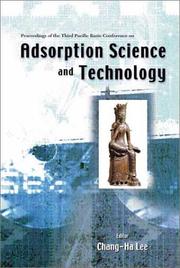
ISBN: 1281906077 9786611906078 9812704329 9789812704320 9812383492 9789812383495 9781281906076 661190607X Year: 2003 Publisher: River Edge, N.J. World Scientific
Abstract | Keywords | Export | Availability | Bookmark
 Loading...
Loading...Choose an application
- Reference Manager
- EndNote
- RefWorks (Direct export to RefWorks)
This book presents the latest research on adsorption science and technology. It serves as an excellent reference for research in areas such as fundamentals of adsorption and ion exchange (equilibria and kinetics), new materials, adsorption characterization, novel processes, energy and environmental processes.
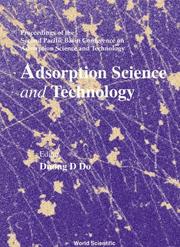
ISBN: 981279333X 9789812793331 9810242638 9789810242633 Year: 2000 Publisher: Singapore River Edge, N.J. World Scientific
Abstract | Keywords | Export | Availability | Bookmark
 Loading...
Loading...Choose an application
- Reference Manager
- EndNote
- RefWorks (Direct export to RefWorks)
This book presents the latest research on adsorption science and technology. It covers various aspects of materials, solid characterization, equilibria, kinetics determination and new processes.
Book
ISBN: 3110452243 311045226X 9783110452266 9783110452242 3110452170 Year: 2016 Publisher: Berlin Boston
Abstract | Keywords | Export | Availability | Bookmark
 Loading...
Loading...Choose an application
- Reference Manager
- EndNote
- RefWorks (Direct export to RefWorks)
Chapter 1 General IntroductionDefinition of emulsions and the role of the emulsifier. Classification based on the nature of the emulsifier. Classification based on the structure of the system. General instability problems with emulsions : creaming/sedimentation, flocculation, Ostwald ripening, coalescence and phase inversion. Importance of emulsions in various industrial applications. Chapter 2 Thermodynamics of Emulsion Formation and BreakdownApplication of the second law of thermodynamics for emulsion formation : Balance of energy and entropy and non-spontaneous formation of emulsions. Breakdown of the emulsion by flocculation and coalescence in the absence of an emulsifier. Role of the emulsifier in preventing flocculation and coalescence by creating an energy barrier resulting from the repulsive energies between the droplets. Chapter 3 Interaction Forces between Emulsion DropletsVan der Waals attraction and its dependence on droplet size, Hamaker constant and separation distance between the droplets. Electrostatic repulsion resulting from the presence of electrical double layers and its dependence on surface (or zeta) potential and electrolyte concentration and valency. Combination of the van der Waals attraction with double layer repulsion and the theory of colloid stability. Steric repulsion resulting from the presence of adsorbed non-ionic surfactants and polymers. Combination of van der Waals attraction with steric repulsion and the theory of steric stabilisation. Chapter 4 Adsorption of Surfactants at the Oil/Water InterfaceThermodynamic analysis of surfactant adsorption and the Gibbs adsorption isotherm. Calculation of the amount of surfactant adsorption and area per surfactant molecule at the interface. Experimental techniques for measuring the interfacial tension. Chapter 5 Mechanism of Emulsification and the Role of the EmulsifierDescription of the factors responsible for droplet deformation and its break-up. Role of surfactant in preventing coalescence during emulsification. Definition of the Gibbs dilational elasticity and the Marangoni effect in preventing coalescence. Chapter 6 Methods of EmulsificationPipe flow, static mixers and high speed stirrers (rotor-stator mixer). Laminar and turbulent flow. Membrane emulsification. High pressure homogenisers and ultrasonic methods. Chapter 7 Selection of EmulsifiersThe hydrophilic-lipophilic-balance (HLB) and its application in surfactant selection. Calculation of HLB numbers and the effect of the nature of the oil phase. The phase inversion temperature (PIT) method for emulsifier selection. The cohesive energy ratio method for emulsifier selection. Chapter 8 Creaming/Sedimentation of Emulsions and its preventionDriving force for creaming/sedimentation: effect of gravity, droplet size and density difference between the oil and continuous phase. Calculation of the rate of creaming/sedimentation in dilute emulsions. Influence of increase of the volume fraction of the disperse phase on the rate of creaming/sedimentation. Reduction of creaming/sedimentation: Balance of the density of the two phases, reduction of droplet size and effect of addition of ''thickeners'. Chapter 9 Flocculation of Emulsions and its PreventionFactors affecting flocculation. Calculation of fast and slow flocculation rate. Definition of stability ratio and its dependence on electrolyte concentration and valency. Definition of the critical coagulation concentration and its dependence on electrolyte valency. Reduction of flocculation by enhancing the repulsive forces. Chapter 10 Ostwald Ripening and its ReductionFactors responsible for Ostwald ripening : difference in solubility between small and large droplets and the Kelvin equation. Calculation of the rate of Ostwald ripening. Reduction of Ostwald ripening by incorporation of a small amount of highly insoluble oil. Reduction of Ostwald ripening by the use of strongly adsorbed polymeric surfactant and enhancement of the Gibbs elasticity. Chapter 11 Emulsion Coalescence and its PreventionDriving force for emulsion coalescence : Thinning and disruption of the liquid film between the droplets. The concept of disjoining pressure for prevention of coalescence. Methods for reduction or elimination of coalescence : Use of mixed surfactant films, use of lamellar liquid crystalline phases and use of polymeric surfactants. Chapter 12 Phase Inversion and its PreventionDistinction between catastrophic and transient phase inversion. Influence of the disperse volume fraction and surfactant HLB number. Explanation of the factors responsible for phase inversion. Chapter 13 Characterisation of EmulsionsMeasurement of droplet size distribution : Optical microscopy and image analysis. Phase contrast and polarising microscopyDiffraction methods. Confocal laser microscopy. Back scattering methods Chapter 14 Industrial Application of Emulsions14.1 Application in Pharmacy14.2 Application in Cosmetics 14.3 Application in Agrochemicals14.4 Application in Paints14.5 Application in the Oil Industry
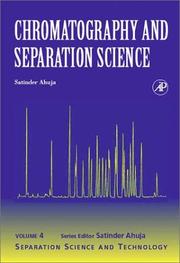
ISBN: 9780120449811 0120449811 9780080501123 0080501125 1281072478 9781281072474 9786611072476 6611072470 Year: 2003 Publisher: Boston Academic Press
Abstract | Keywords | Export | Availability | Bookmark
 Loading...
Loading...Choose an application
- Reference Manager
- EndNote
- RefWorks (Direct export to RefWorks)
The basic objectives of this book are to: provide basic information on chromatography and separation science; show how simple extraction and partition processes provide the basis for development of chromatography and separation science; describe the role of chromatography and separation science in various fields; discuss the role of chromatography and separation science in development of new methodology; and present new evolving methods and how to select an optimum method.· The book covers the fundamental physical and chemical phenomena involved in separations· Provides a concise o
Book
ISBN: 1612094163 9781612094168 9781607416388 1607416387 Year: 2010 Publisher: New York Nova Science Publishers
Abstract | Keywords | Export | Availability | Bookmark
 Loading...
Loading...Choose an application
- Reference Manager
- EndNote
- RefWorks (Direct export to RefWorks)
Book
ISBN: 1621980278 0873353579 9780873353571 9781621980278 9780873353397 0873353390 Year: 2012 Publisher: Englewood, Colo. Society for Mining, Metallurgy, and Exploration
Abstract | Keywords | Export | Availability | Bookmark
 Loading...
Loading...Choose an application
- Reference Manager
- EndNote
- RefWorks (Direct export to RefWorks)
Separation Technologies for Minerals, Coal, and Earth Resources is an authoritative digest of the latest developments in the mineral processing industry. Dozens of authors share their insights on how practitioners can develop earth resources more economically while simultaneously addressing vital factors ranging from sustainability to environmental stewardship.
Separation (Technology) --- Coal --- Cleaning.
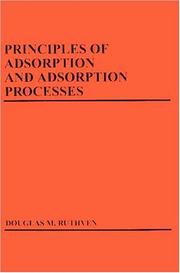
ISBN: 0471866067 Year: 1984 Publisher: New York Wiley & Sons
Abstract | Keywords | Export | Availability | Bookmark
 Loading...
Loading...Choose an application
- Reference Manager
- EndNote
- RefWorks (Direct export to RefWorks)
Surface chemistry --- fysicochemie --- Adsorption. --- Separation (Technology).
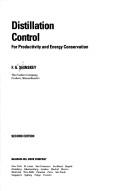
ISBN: 0070568944 Year: 1984 Publisher: New York (N.Y.): MacGraw-Hill
Abstract | Keywords | Export | Availability | Bookmark
 Loading...
Loading...Choose an application
- Reference Manager
- EndNote
- RefWorks (Direct export to RefWorks)
Distillation --- Rectification of spirits --- Separation (Technology) --- Liquors
Book
ISBN: 0128015993 0128015896 1322554765 9780128015995 9780128015896 9780128015896 Year: 2015 Publisher: Amsterdam, Netherlands : Elsevier,
Abstract | Keywords | Export | Availability | Bookmark
 Loading...
Loading...Choose an application
- Reference Manager
- EndNote
- RefWorks (Direct export to RefWorks)
The Boundary Flux Handbook summarizes over 100 chemical compounds (single compounds, in mixed solution) and different feed streams from industry (complex streams exiting the agricultural, biological, pharmaceutical, food, dye, textile, and other industries) and the respective critical and threshold fluxes (or boundary flux), together with data on rejection and permeabilities. It gives the reader valuable data to quickly estimate membrane performances in respect to productivity, selectivity, and longevity, and aids in estimating capital and operating costs of membrane processes during the plan
Membranes (Technology) --- Artificial membranes --- Separation (Technology) --- Technology
| Listing 1 - 10 of 246 | << page >> |
Sort by
|

 Search
Search Feedback
Feedback About UniCat
About UniCat  Help
Help News
News